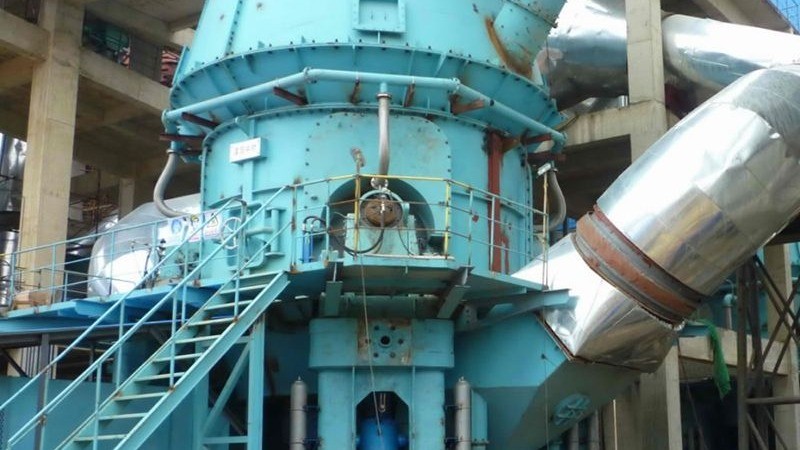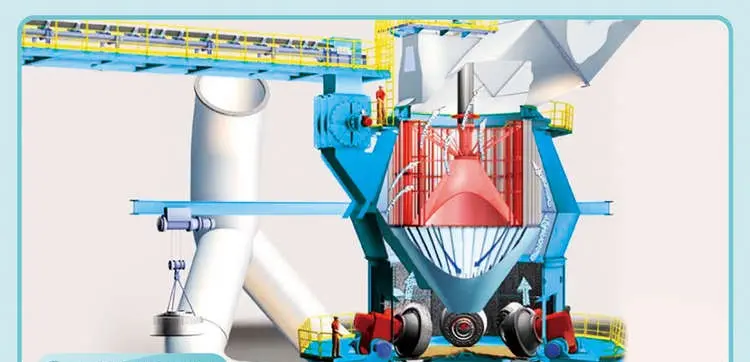Vertical mills have transformed the manufacturing landscape by providing highly efficient, versatile grinding solutions. Widely used in industries such as cement production, thermal power, mineral processing, and non-ferrous metal production, vertical mills are known for their efficiency, compact design, and ability to handle a variety of raw materials. Unlike traditional ball mills, vertical mills offer a streamlined, space-saving process flow that enhances efficiency, simplifies operation, and reduces the environmental impact.

Vertical mills not only process raw materials more consistently, supporting even calcination, but also generate a uniform particle size, a feature crucial for achieving product quality in downstream processes. These systems enable manufacturers to maintain high operational standards and reduce the footprint of grinding operations. However, the high friction, temperature, and pressure within these mills create severe wear issues, posing a significant challenge to maintaining their performance over time.
As vertical mills handle massive volumes of abrasive materials, critical components inevitably face wear that can lead to costly downtime and increased maintenance. The primary wear points in a vertical mill grinding system include:
Roller Sleeves and Shaft Guards: These are subjected to high friction as they grind down raw materials.
Wind Guide Rings and Mill Cylinders: Consistent exposure to abrasive dust causes these parts to erode.
Separator Cones and Support Rods: Essential for particle size distribution, they experience continuous wear.
Infeed Chutes and Roller Seals: Constant material input and sealing requirements expose these parts to persistent wear.
Oil Pipe Guards and Mill-to-Cyclone Piping: These are crucial for maintaining system integrity and preventing leaks.
Given the centrality of these components to system efficiency, implementing effective wear protection strategies is essential. Neglecting wear protection not only reduces the system’s overall productivity but also increases repair and replacement costs, impacting the operational budget and limiting system uptime.
Ceramic technology has advanced considerably, offering industries highly durable and resilient materials for wear protection. Ceramic materials are renowned for their hardness, corrosion resistance, and heat tolerance—making them ideal for high-stress applications in vertical mill grinding systems. Various ceramics-based strategies can target specific wear points within these systems:
Roller shaft guards and wind guide rings are some of the most impacted areas in vertical mills, as they handle intense grinding friction and high temperatures. By incorporating thick ceramic blocks installed using dovetail rail technology, these components achieve durable protection that mitigates wear over extended periods. Dovetail ceramic blocks fit securely in place, preventing them from shifting even under intense wear conditions. This setup ensures that parts remain protected against high-impact grinding and reduce frequent downtime.
Infeed chutes and separator cones play a crucial role in material input and size distribution. To extend the lifespan of these components, industries employ dovetail ceramic blocks externally and adhesive ceramic tiles internally. This dual-layer protection offers resistance to constant abrasion, ensuring the materials maintain their structure and function. Furthermore, the combination of external and internal ceramic applications enhances the system's overall performance by minimizing particle scattering and dust emissions.
Support rods provide structural stability within vertical mills, yet they can experience accelerated wear due to consistent load-bearing. Integrated wear-resistant ceramics on these rods extend their operational life and reduce maintenance requirements. Using integrated ceramic linings for support rods not only strengthens their resilience against wear but also facilitates easier maintenance.
Given their exposure to high temperatures and abrasive dust, separator housing and cyclone piping benefit significantly from high-temperature adhesive-bonded ceramics. This ceramic application technique creates a protective layer that withstands intense heat, enabling these components to operate without frequent interruptions. High-temperature ceramics are particularly advantageous in cyclone areas, where rapid material movement could otherwise accelerate wear.
Roller seals require protection against abrasive forces, as they form the system’s barrier against leaks and maintain pressure. By embedding ceramic tiles in rubber using hot vulcanization, the roller seals gain enhanced durability, providing a dual-layered protection system that absorbs impacts and prevents seal deterioration. This technique is effective in ensuring prolonged functionality of the sealing components, reducing the risk of leaks that can compromise system efficiency.
Fixed guide vanes manage airflow within the mill, playing a vital role in optimizing grinding conditions. These vanes face persistent abrasive forces, which can reduce their efficiency over time. To address this, a combination of dovetail ceramics and adhesive applications protects the vanes, preserving their structural integrity and ensuring consistent airflow regulation.
Oil pipes are essential for lubrication and system cooling. Wear-resistant S-type ceramics effectively shield oil pipes, safeguarding them against wear from abrasive particles and high heat. Applying S-type wear-resistant ceramics provides an additional layer of protection, reducing the risks of leaks and pipe degradation, thereby maintaining optimal lubrication and cooling in the grinding system.
Ceramic solutions provide extensive benefits in raw material vertical mill grinding systems, offering improved operational efficiency, enhanced environmental protection, and substantial cost savings. Here’s a deeper look into these benefits:
Ceramic materials, due to their exceptional hardness, offer superior protection against wear. Components shielded with ceramics experience prolonged service lives, reducing the frequency of replacements and maintenance needs. This longevity translates into increased uptime and a smoother, more reliable grinding operation.
Effective wear protection using ceramics minimizes leaks and other emissions, contributing to a cleaner and safer workplace. By lowering dust production and noise levels, ceramic solutions also contribute to environmental goals, supporting industries in meeting regulatory standards for air quality and noise pollution.
Ceramic materials help absorb impact and reduce friction, leading to lower noise levels during operation. The reduced noise enhances working conditions and aligns with regulatory guidelines for noise management in industrial settings. In addition, ceramics’ abrasion resistance helps reduce dust production, making the work environment safer and reducing the load on dust filtration systems.
Ceramic solutions can be customized for specific wear points within the grinding system, allowing industries to implement targeted protection strategies. This adaptability ensures that high-wear components receive the most robust protection, optimizing system longevity and enhancing overall efficiency.
The development of ceramic technology has advanced significantly, offering industries even more robust and versatile solutions. New materials, such as nanoceramics and high-density ceramics, offer enhanced durability and wear resistance. Additionally, advancements in bonding techniques—like high-temperature adhesives and dovetail ceramic block designs—provide secure applications even in the harshest environments. These innovations ensure that ceramic solutions remain durable, reducing replacement frequency and lowering total ownership costs.
Nanoceramics, for instance, are revolutionizing the field with their microscopic particle structure, which provides enhanced toughness and impact resistance. By integrating these advanced ceramics, industries can achieve longer-lasting wear protection, further reducing maintenance demands.

In a large cement manufacturing plant, frequent wear on grinding system components was causing regular downtime and escalating maintenance costs. By installing thick ceramic blocks on roller sleeves and using dovetail ceramics on separator housing, the plant significantly reduced wear rates. As a result, the facility achieved over 30% improvement in uptime, and maintenance frequency dropped by nearly 40%, highlighting ceramics' effectiveness in high-wear environments.
A mineral processing facility faced severe abrasion on its cyclone piping and separator cones due to constant particle flow. Implementing high-temperature adhesive-bonded ceramics in these areas allowed the plant to enhance wear resistance, achieving uninterrupted operation for extended periods. This improvement in equipment reliability and reduced wear replacement costs translated into considerable savings and improved efficiency.
Ceramic solutions may have a higher initial cost compared to standard wear protection methods; however, they offer a high return on investment (ROI) over time. The long-term cost savings result from reduced maintenance expenses, longer component lifespan, and improved system uptime. In many industries, adopting ceramic-based wear protection yields up to 50% savings in maintenance costs, and ROI can be realized within the first two years of operation.
Several factors influence these savings, including the frequency of maintenance intervals, cost of replacement parts, and potential losses due to downtime. With ceramic solutions, plants experience fewer unplanned shutdowns, allowing for consistent production and minimizing financial losses from operational delays.
Sanxin New Materials Co., Ltd. has established itself as a leader in wear-resistant ceramics, producing advanced ceramic products tailored for industrial applications. With a commitment to innovation, Sanxin offers a wide range of solutions, including ceramic milling balls, nanoparticles, nanopowders, and customized wear-resistant ceramics designed to meet the unique challenges of high-wear environments.
Sanxin’s products are rigorously tested to ensure durability, heat resistance, and exceptional performance in demanding applications. For more information on Sanxin’s range of products or to discuss a custom solution, reach out via WhatsApp at +86 19070858212 or email at sales@beadszirconia.com.

Submit your demand,
we will contact you ASAP.

Sanxin New Materials Co., Ltd. focus on producing and selling ceramic beads and parts such as grinding media, blasting beads, bearing ball, structure part, ceramic wear-resistant liners, Nanoparticles Nano Powder

